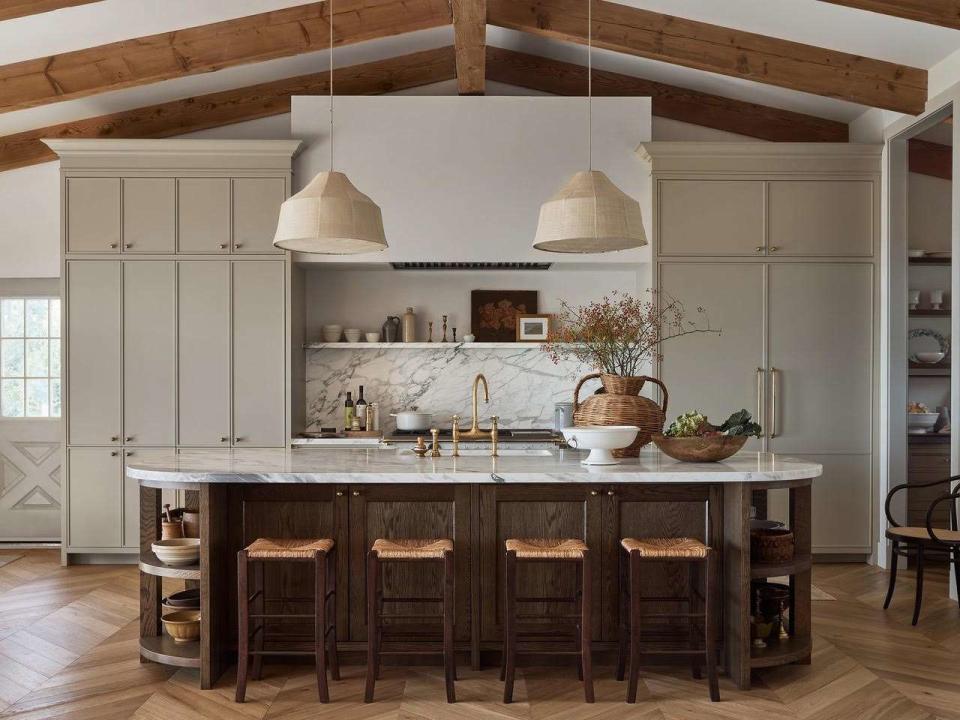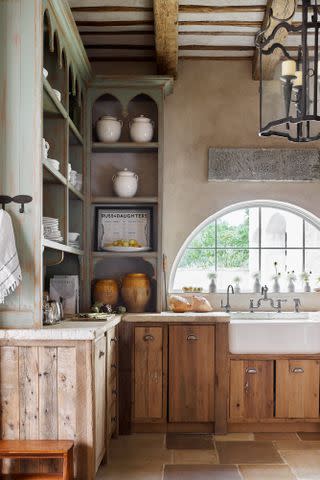Designers Say Curvy Kitchens Are In for 2024
Experts chime in on the latest kitchen design trend guaranteed to elevate your space.

Courtesy of Ashley Montgomery Design / Lauren Miller
There's been a resurgence of curvy kitchens lately, thanks to the design style's softening effect and user-friendly appeal. Curved lines in design communicate graceful movement while injecting a sense of energy into a space. And since kitchens are the heart of the home, it's the perfect place to experiment with a curved aesthetic, especially if you're drawn to cozy, welcoming spaces.
Like many home design details, trends can dictate which styles steal the spotlight—and experts say curved kitchen elements are going to be one of 2024's hottest looks. Curved kitchen islands took off in 2023, and designers say the style is expanding into the rest of the kitchen. To give you the full scoop on the curvy kitchen design trend, professional interior designers are sharing their insights on why this style is here to stay.
Related: 23 Timeless Kitchen Design Ideas That Are Here to Stay
MEET THE EXPERTS
Mindy O'Connor is the principal architect and founder of Melinda Kelson O'Connor Architecture & Interiors in Philadelphia, PA.
Victoria Holly is the principal and founder of Victoria Holly Interiors in Los Angeles, CA.
Devon Wegman is the design director and founder of DGI Design x Build in Chicago, IL.
What Is a Curvy Kitchen?
Interior trend forecasts predict curvy kitchens will make a comeback in 2024. But what exactly is a 'curvy kitchen?' It's a dynamic trend that we first reported on in a 1944 issue of Better Homes and Gardens. To classify as a curvy kitchen, the space must include elements like "an arched doorway, rounded island, cabinetry corners or curved hoods," says interior designer Victoria Holly. But that's not all—rounded countertops also check the box for a curvy kitchen, offering a smoother flow of movement that makes the space more user-friendly, Holly adds.
Related: 4 Ways to Try the Curved Furniture Trend That's Everywhere Right Now
What's the Best Way to Add a Curved Element in a Kitchen?
Typically located in the center of the room, a kitchen island double-duties as a design focal point and flexible prep space that separates work and guest areas. Plus, today's kitchen islands can be as flexible as we need them to be, boasting storage, extra seating, and design flair. This "eat-bar" concept can also be a gathering hub for family meals and celebrations. For these reasons, we love an island's utilitarian and design impact, making it the ideal spot to add a curved element.
"Curved islands and countertops add a sense of fluidity and grace to the kitchen, making it feel more elegant and less rigid," Holly says. Curving islands also provide a softer edge to lean up against, which is ideal for busy families or entertaining.
Curved pieces naturally reflect a soft and peaceful feeling, key in kitchen spaces that "can often feel sharp and cold, especially in more modern settings," says designer Devon Wegman. Curved edges also add intrigue, making the space feel more inviting, he adds. Wagman, who often uses radius-edged countertops to soften his client spaces, employs this design technique to create more comfortable traffic and circulation patterns in a space.
Rounded Countertop Edges
If you like the concept of rounded-edged countertops, scout several choices that can be applied to granite, quartz, and marble. For example, try double-radius, demi-bullnose, bullnose, or standard ogee edges. It's worth taking some time to investigate each style and choose one that fits your design goals and is available through your countertop fabricator. Keep in mind that some edges might come with an upcharge.
Why Are Curvy Kitchens Becoming Popular?
Architect Mindy O'Connor attributes the the curvy kitchen trend to their basic design element—rounded edges. "Functionally, they are approachable and less harsh to walk into," she says. "This can be inviting for families and make a smoother entrance into a space. Aesthetically, circles are a historically important form symbolizing unity and infinity because they have no beginning or end. Curving forms can create a softness and prettiness by their very nature."
"The trend toward rounded edges also allows for more customization in kitchen design and creates the feel of a completely custom kitchen," Holly adds. "The absence of sharp angles and corners helps reduce the visual harshness of a space."
Designers hold mixed reviews about the staying power of curvy kitchens. While some feel it's a sought-after feature that has lasting power, others consider it a trend that will tire eventually. Straight edges may be considered more timeless when comparing both styles side by side. Still, the safest way to incorporate curved kitchen features is to mix and match linear elements for a layered look that feels curated versus trendy.
Consider Shapes and Lines
Two essential elements designers use to achieve good design is shape and line—these tools serve as visual grammar to help us understand the spaces around us. For example, circles in interior design represent unity, safety, and infinity. Rectangles and squares symbolize order and formality. Horizontal lines can promote feelings of stability and security, while vertical lines can communicate height and strength. Diagonal lines can suggest movement or action.

Emily J Followill
How to Get the Look in Your Kitchen
If you're considering a kitchen refresh, take a holistic account of your space as is. Which linear elements do you have now that make the space feel too rigid? Which design opportunities does your space allow for a curvier update? Then, scout which subtle touches would make the best design statement for you. Remember, "Mixing curved and straight lines can create a balanced and dynamic visual composition," Holly says, so it's key to use both elements in harmony.
O'Connor agrees, suggesting the use of arches, which "offer a welcoming signal that can be a beautiful marking of the entrance to a space, or denote an important feature or special nook," she says.
Related: 9 Arched Doorway Ideas That Will Elevate Your Home
For more Better Homes & Gardens news, make sure to sign up for our newsletter!
Read the original article on Better Homes & Gardens.

